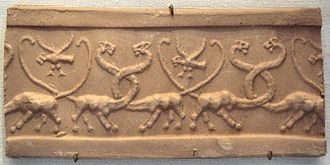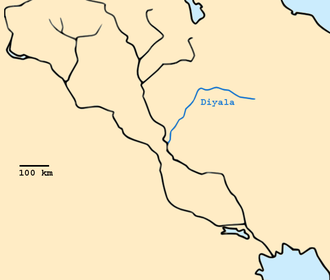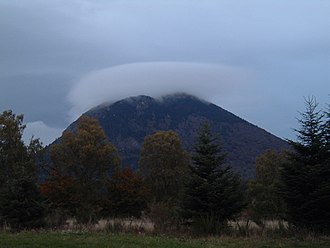Lion eagle
The lion eagle (also lion-headed eagle ; Sumerian an an x (IM) -du-gud ; an mušen ; Akkadian angud, an ) is documented as a bird of prey- like hybrid creature in Mesopotamian glyptics from the Jemdet-Nasr period to the end of the New Sumerian period ; initially in two basic types, later only as a floating lion eagle. In the Syrian region, the lion eagle appeared iconographically with Mesopotamian motifs for a short time in the early second millennium BC. In appearance.
The lion eagle was composed of a lion's head and a body of a bird of prey and was initially the strongest bird and the most dangerous predator in the mythology of the time, which threatened people and herds of cattle . The Mesopotamian kings therefore compared their character to that of a lion eagle. In the Gilgamesh epic in the ancient Babylonian period (around 2000–1600 BC), the Chumbaba appears to be breathing fire, although it is sometimes referred to in the literature as the “lion eagle”, but is to be equated with the lion kite .
etymology
The original etymology of the Sumerian word “zu mušen ” has not been clarified with certainty , since an is a loan word from the Elamite language . The name component to define the lion eagle to the sky belong. Anzu can refer as a generic term to the complex of topics air , storm , wind or clouds .
In Sumerian mythology the kings compared the lion eagle to more often with the essence of the deity Enlil , whose name Mr. Wind and Lord of the loud word means. In addition, the loud scream of Anzu has been described in Sumerian literature as terrifying and unpleasant . Another mythological reference of the to is the connection made by the kings with the mountainous region.
The Sumerian term mušen means bird and generally refers to the entire species. In order to specify received bird subspecies the word Appendix muses . Taking into account all factors, “to have to ” are interpreted as petrel , cloud bird or mighty / strong cloud bird .
Representations
The "Type A" motif stands symbolically for the lion eagle acting as a lion, which therefore always functions crouching on the ground in this appearance. “Type B”, on the other hand, shows the lion eagle in the role of a bird of prey that hovering over other living beings.
The characteristics of the Sumerian Imdugud in the Ğemdet-Nasr period and the first two early dynastic epochs have nothing in common with the later Akkadian Anzu , although there are similarities in iconography. In addition, depictions of animals were only associated with deities in the early dynastic period.
Ğemdet-Nasr period (around 3100–2900 BC)
Type a

(around 3000 BC), today in the Louvre , Paris
Head-front view of a crouching lion eagle with its wings folded. The front view of the lion's head should be mentioned as a special feature, since the lion was otherwise not shown from the front in this epoch. The motif of a lion eagle looking to the side is documented only once. Type A was used on amulets , staffs and inscriptions .
Type B
Side view of a soaring lion eagle with wings outstretched. Type B was always shown on cylinder seals from Uruk in the top register above other living beings. The depictions show him on the one hand over tied up enemies or together with other animals, on the other hand over other hybrid creatures and probably in a processional scene over other animals in front of a temple.
Early Dynastic Periods I and II (about 2900-2550 BC)

In the first two early dynastic epochs, no lion-headed eagle representations are documented in the Diyala region. Iconographic evidence of type A can only be regarded as probable for the third section of the early dynastic period.
In Girsu , the type B lion eagle appears floating on seals over waterfowl , although the meaning remains unclear. Numerous examples are represented on clubs, consecration plates and seals from Lagaš where the lion eagle hovers over two lions in animal fighting motifs . The scenery was evidently very popular, as there was a further increase in the third early dynastic epoch.
In addition, this type B iconography was often used as a filling or separating element in the representations. In addition, the soaring lion eagle can be seen over several animals on numerous amulets made of the most precious materials. In addition, Type B may have served as a magical decoration on shell pendants . However, an unequivocal confirmation cannot be made because the lion's head cannot be clearly identified.
Imdugud-Sukurru period (around 2550-2340 BC)
Type a
The Imdugud-Sukurru period is marked by several changes in the glyptic ; for example, the lions can now also be seen standing alone in the front view. It is therefore not surprising that the lion's head of the bird of prey was also consistently presented from the front. The body itself was positioned in side view with its wings attached. What was new, however, was the location of the lion eagle on the back of a human- faced bull ; less often, however, the combination with the natural bull model.
The lion eagle's opponent was a bull man who defended the herds of cattle in the event of attacks by the lion eagle on the earth. The positional arrangement of the lion eagle, which has now replaced the lion iconographically with regard to its bull attacks, is striking. On the other hand, the lion eagle grew into the typological counterpart of a lion in this epoch , whose target was individual goats . It seems as if this phase represented the starting point of a mythological role change, which continued until the beginning of the Akkad period .
Type B
In the Imdugud-Sukurru period, the lion eagle hovered with widely spread wings that were turned forward, with the head, similar to type A, in a new version also in frontal view. Mostly, there were content-related motif combinations with billy goats or deer arranged in pairs . In contrast to type A, variants with cattle-like species or lions rarely appeared .
At the same time, the lion eagle of type B and type A was given an iconographic counterpart in the form of a natural bird of prey, which attacked various herds of cattle in parallel with spread wings . However, his head was always shown in side view. The content of the bird of prey and the lion eagle was primarily about fighting scenes in which unsuspecting animals were attacked and killed.
Akkad Period and New Sumerian Era (around 2340–2000 BC)
The type B lion eagle can be seen in its new form during the Akkad period as a hovering bird with a lion's head and spread wings, with the lion's head always looking to the side. In addition, he also appeared as a double head in rare illustrations. Type A, however, was no longer considered.
In the Neo-Sumerian era , the floating lion eagle is often depicted as a motif between a person with outstretched arms and a mostly female deity, whereby the lion eagle occupies the position that was mostly occupied by a star or the moon . The head, which is also here to the side, can only rarely be identified typologically as a lion's head, as the open beak on the head in almost all cases more closely resembles a bird of prey.
The very rare motif of a lion eagle hovering over two lions, which was incorporated twice on the Gudeastele, comes from the reign of Gudea . The classification of the Anzu as a lion eagle made in this context is not certain, as that derivation refers to the partially unclear text of the Gudeastele.
“His brick form“ box ”on which he had scratched a drawing and his stamp (?), Which he had deeply impressed, (bore) an anzu, the emblem of his master ( Ningirsu ); he decorated it to a standard (?). "
On the basis of other depictions of the earlier type of lion eagle, for example from the time of Eannatum , the Assyriologists consider it likely that the mentioned Anzu on the Gudeastele is a lion eagle.
See also
literature
- Jeremy Black: The Imagery of Birds in Sumerian Poetry. In: Marianne Vogelzang: Mesopotamian Poetic Language: Sumerian and Akkadian. Styx, Groningen 1996, ISBN 90-72371-84-4 , pp. 23-46 (English).
- Eva-Andrea Braun-Holzinger: Lion eagle. In: Erich Ebeling , Dietz-Otto Edzard (Hrsg.): Reallexikon der Assyriologie und Vorderasiatischen Aräologie . Volume 7, de Gruyter, Berlin 1990, ISBN 3-1101-0437-7 , pp. 94-97 ( page views in the Google book search).
- Wolfgang Heimpel: Animal images in Sumerian literature. Pontificium Institutum Biblicum, Rome 1968, pp. 433-439.
- Franciscus Antonius Maria Wiggermann: Mesopotamian Protective Spirits: The Ritual Texts. Styx, Groningen 1992, ISBN 90-72371-52-6 (English; doctoral thesis University of Amsterdam; 10 locations for “lion… eagle” in the Google book search ).
- Franciscus Antonius Maria Wiggermann: hybrid creatures. In: Dietz-Otto Edzard u. a .: Real Lexicon of Assyriology and Near Eastern Archeology . Volume 8, de Gruyter, Berlin 1997, ISBN 3-11-014809-9 , pp. 222-264 (English; partial views in the Google book search).
Web links
Remarks
- ↑ a b c Franciscus-Antonius-Maria Wiggermann: Hybrid beings (A) . Pp. 243-244.
- ↑ Jeremy Black: The Imagery of birds in Sumerian poetry . P. 25.
- ↑ For example Šulgi : Wolfgang Heimpel: Tierbilder in der Sumerischen Literatur . P. 436.
- ↑ Stefan M. Maul: The Gilgamesh epic . Beck, Munich 2008, ISBN 978-3-406-52870-5 , p. 78.
- ^ A b Eva-Andrea Braun-Holzinger: Löwenadler . P. 96.




